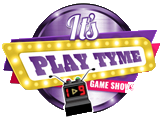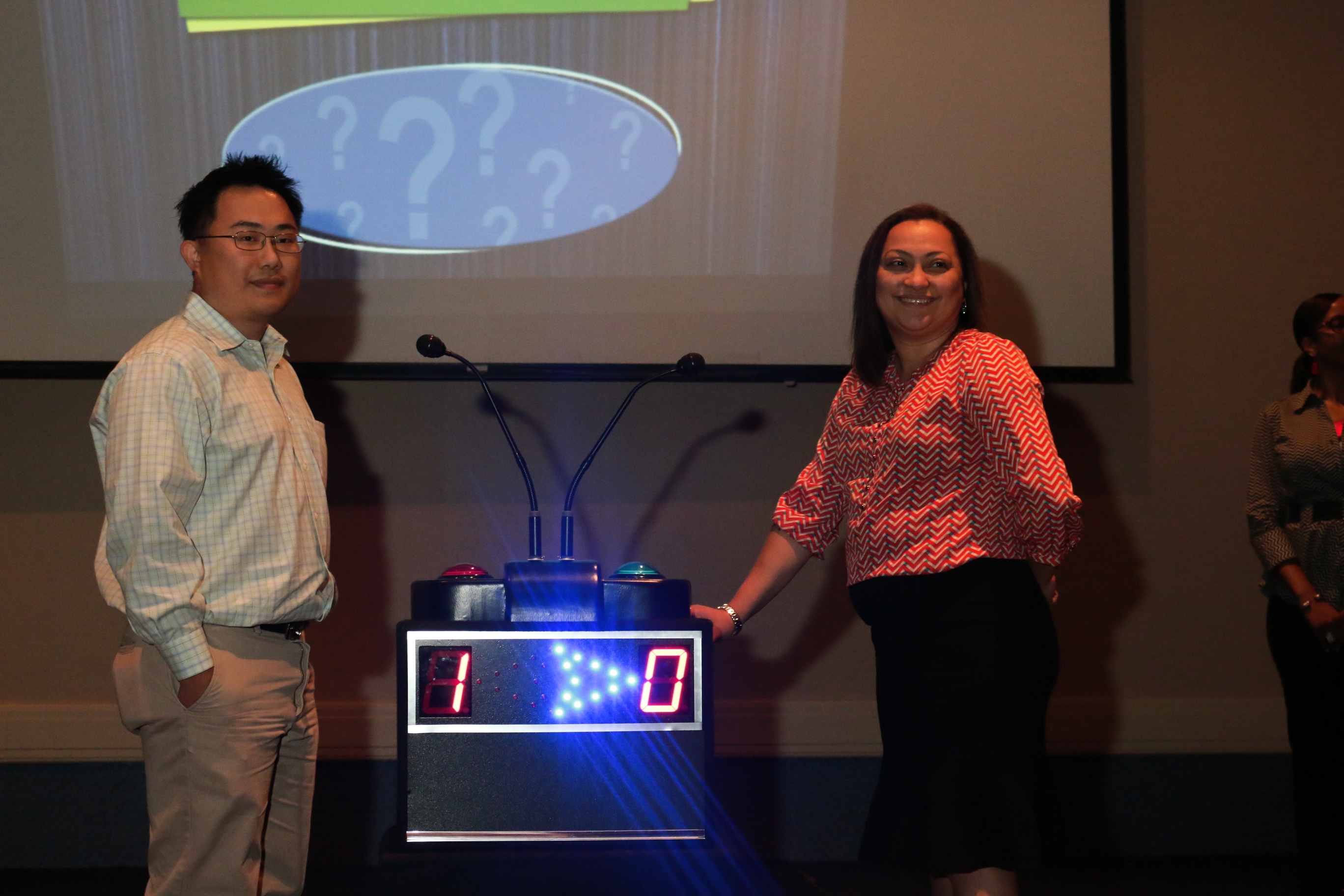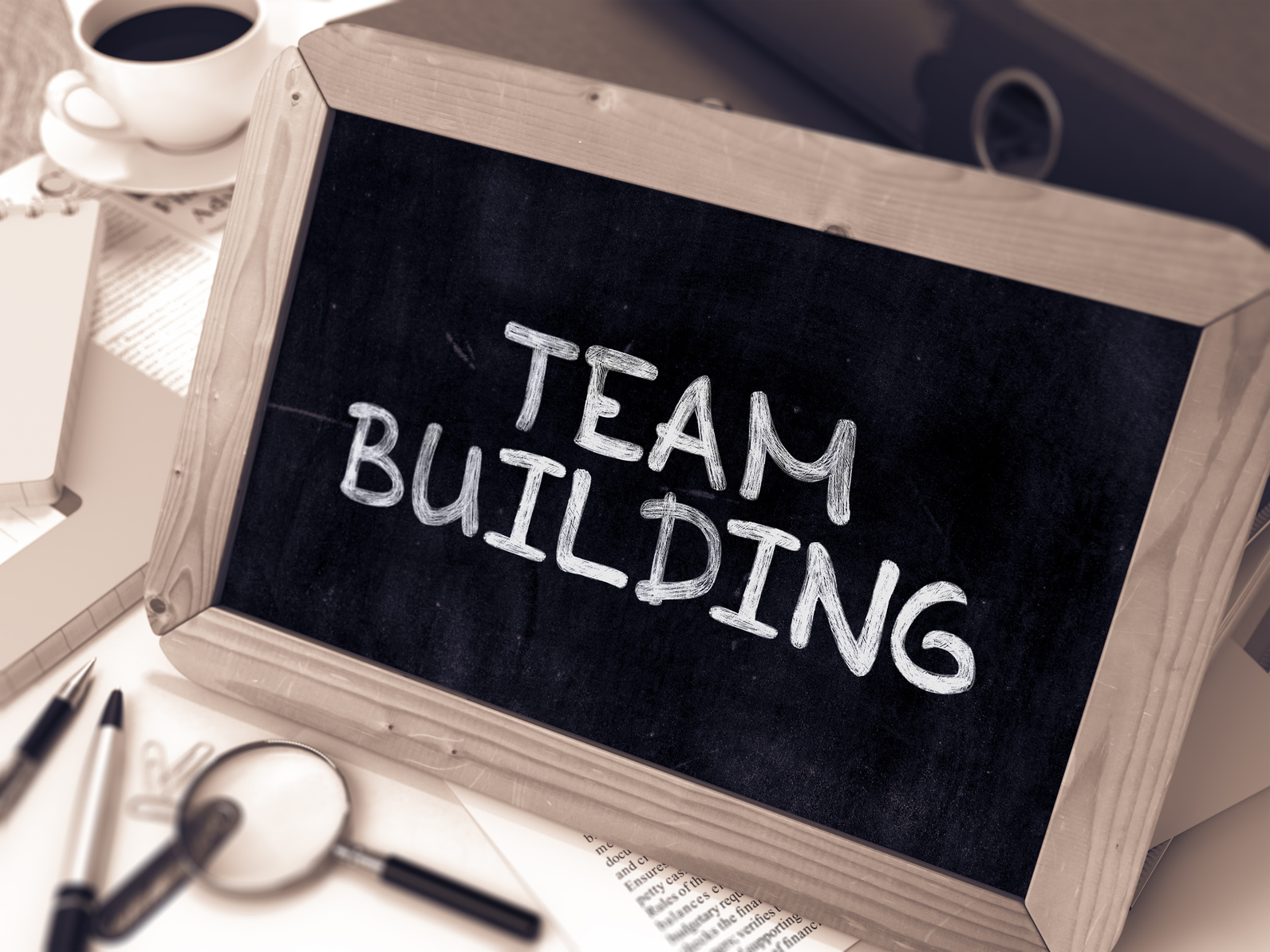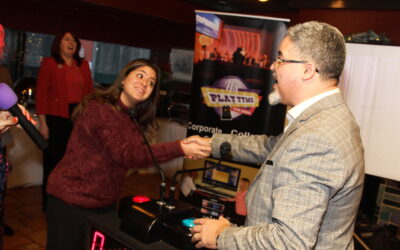Did you know that companies investing in team building activities see a significant boost in productivity? As organizations strive to foster a collaborative and engaging work environment, team bonding has evolved to address modern workplace challenges.
In today’s business landscape, it’s crucial to implement activities that not only strengthen relationships among team members but also enhance communication skills and promote team collaboration.
This comprehensive guide explores the most effective team activities for 2025, designed to engage employees and drive measurable results.
Key Takeaways
- Discover the most effective team building activities for 2025.
- Learn how modern team building addresses contemporary workplace challenges.
- Explore a range of activities to develop specific skills like communication and problem-solving.
- Understand how to implement these activities successfully in your organization.
- Find out how these activities can strengthen relationships and enhance team collaboration.
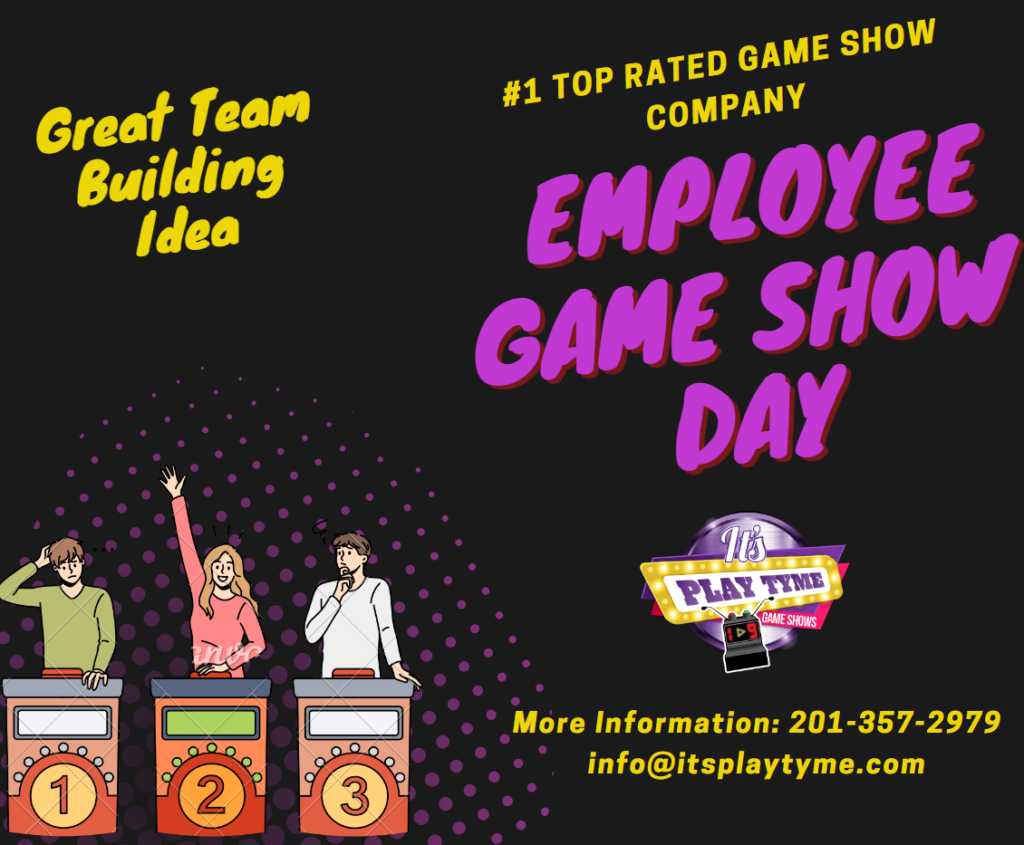
employee-engagement-game-show-idea
The Importance of Team Building in the Modern Workplace
The modern workplace demands more than just individual effort; it requires a cohesive team that works together seamlessly. Team-building events are a continuous process necessary to form stronger ties between workers and the company.
Benefits of Regular Team Building Activities
Regular team activities are essential for a modern workplace. They help in creating a foundation for improved morale, better communication, and increased trust among colleagues.
- Improved morale and better communication among colleagues
- Higher employee engagement rates, with approximately 13% of employees asserting they are more productive when happy
- Streamlined onboarding process for new hires
- Increased trust and creativity among team members
- Lower turnover rates due to stronger team bonding
How Team Building Impacts Company Culture
Team building directly impacts company culture by fostering friendship and community, transforming a group of individuals into a cohesive unit with shared goals and values. When employees work together in non-work contexts, it reveals strengths and abilities that might not be apparent in regular work settings.
Team Building and Employee Retention
Research shows that companies with strong team bonding initiatives experience lower turnover rates as employees develop deeper connections to their colleagues and organization. Effective team-building activities help in retaining employees by making them feel valued and part of the team.
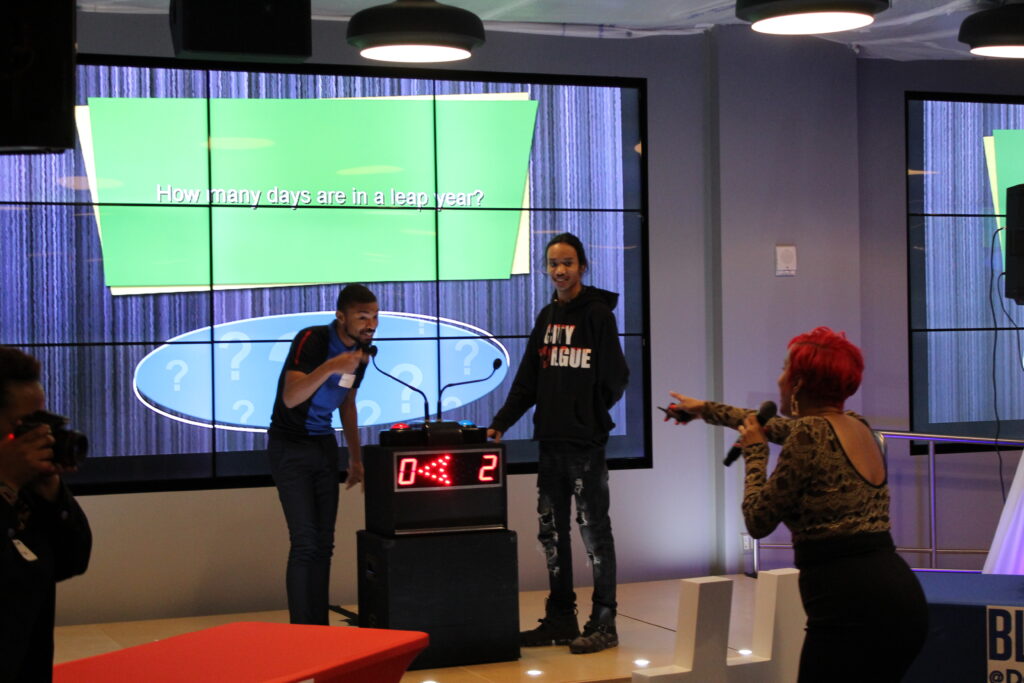
Comedy Game Shows – Team Building Activities
Effective Workplace Team Building – The 7 C’s
The 7 C’s of team building are fundamental elements that contribute to the development of strong and effective teams in the workplace. These elements are designed to improve collaboration, communication, and overall team performance, ultimately leading to the success of the organization.
Communication: The Foundation of Teamwork
Effective team building starts with strong communication skills. It’s the foundation upon which successful teams are built, ensuring that all team members understand their roles and can share ideas and feedback openly without fear of judgment. This open line of communication fosters a collaborative environment where everyone works together towards common goals.
Collaboration: Working Together Toward Common Goals
Collaboration encourages team members to work together, combining their diverse skills and perspectives to achieve better results than they could individually. By fostering an environment where team members support each other, organizations can build a cohesive unit that is greater than the sum of its parts.
Commitment: Building Dedication Within Teams
Commitment involves team members taking ownership of their tasks and demonstrating dedication to the team’s objectives. This not only builds reliability and accountability but also ensures that every team member is working towards the same goals, thereby enhancing overall team performance.
Competence: Developing Skills Through Team Activities
Developing the necessary skills through team activities is crucial for ensuring that each team member can contribute effectively to the team’s success. By focusing on competence, organizations can enhance their team’s ability to tackle challenges and achieve their objectives.
Confidence: Fostering Trust Among Team Members
Building trust among team members is essential for creating an environment where people feel safe to take risks, share ideas, and support one another through challenges. When team members have confidence in each other, they are more likely to work together effectively and achieve their goals.
Creativity: Encouraging Innovative Thinking
Encouraging creative thinking allows teams to develop innovative solutions to challenges. In today’s rapidly changing business landscape, the ability to think creatively and approach problems from different angles is increasingly important for staying ahead of the competition.
Cohesion: Creating Unity Within Teams
A cohesive team is one that works well together, has a strong sense of unity, and aligns with shared values and goals. Cohesion is critical for ensuring that the team can function smoothly even in challenging situations, making it a key element of effective team building.
By understanding and implementing the 7 C’s of team building, organizations can create a comprehensive approach to developing strong, high-performing teams that can effectively tackle workplace challenges.
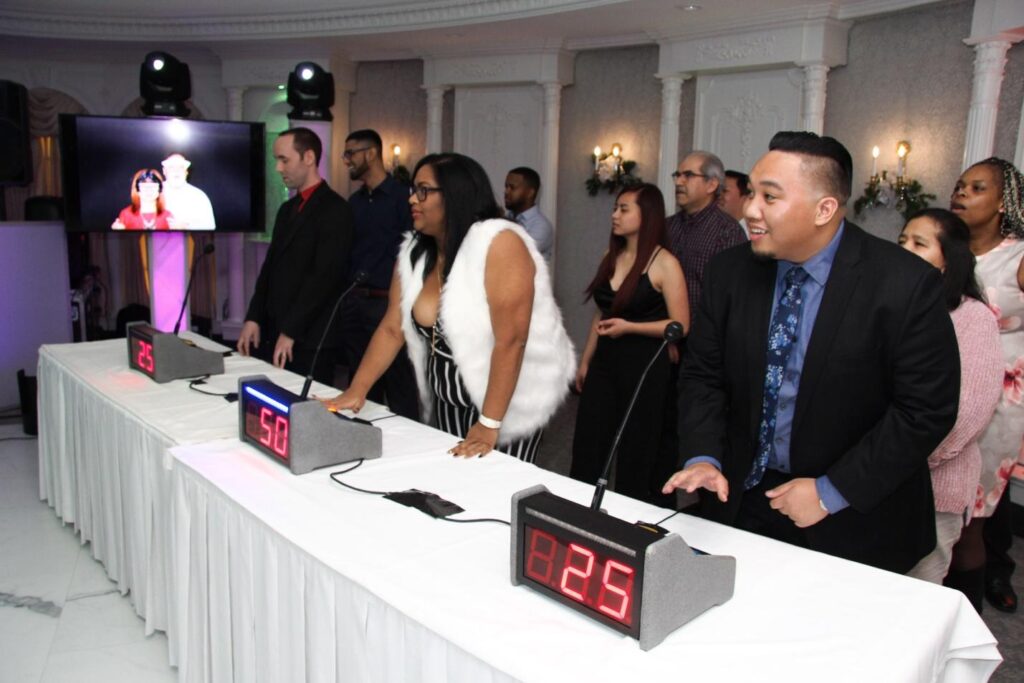
Trivia – Game show Mania
Quick Icebreaker Activities for New Teams
When forming new teams, icebreaker activities play a crucial role in establishing a comfortable and interactive environment. These activities are designed to help new team members get to know each other, break the ice, and foster a sense of camaraderie that is essential for effective team building.
Two Truths and a Lie
This engaging activity is perfect for groups of 5-8 people and requires a time commitment of about 30 minutes. Participants share two true statements and one false statement about themselves, and the others have to guess which one is the lie. This game encourages personal sharing and creates immediate conversation starters, helping to build familiarity between colleagues.
The One-Word Icebreaker Game
Suitable for groups of 4-5 people, this activity takes about 20 minutes. Participants describe a work situation or project with just one word, followed by a group discussion on why those words were chosen. This game provides valuable insights into team perspectives and fosters understanding among team members.
Office Trivia Challenge
This activity is ideal for groups ranging from 5 to 20 people and can take anywhere from 30 to 45 minutes. By using lighthearted questions about the workplace, new employees can learn about company culture while engaging with their colleagues. It’s an effective way to combine fun with organizational knowledge.
A Penny for Your Thoughts
For groups of 5-7 people, this activity requires about 35 minutes. Participants pick a coin and share a significant event that happened to them in the year printed on the coin. This activity promotes personal storytelling and helps build personal relationships between workers.
What Do We Have in Common?
This activity is particularly effective for larger groups of 20-50 people and takes about 40-60 minutes. Team members work together to identify shared interests, experiences, or preferences, helping to build connections across different departmental lines.
These quick icebreaker activities are not only fun but also serve as a foundation for more effective team building. By incorporating such activities, teams can establish a strong bond, enhance collaboration, and improve overall performance.
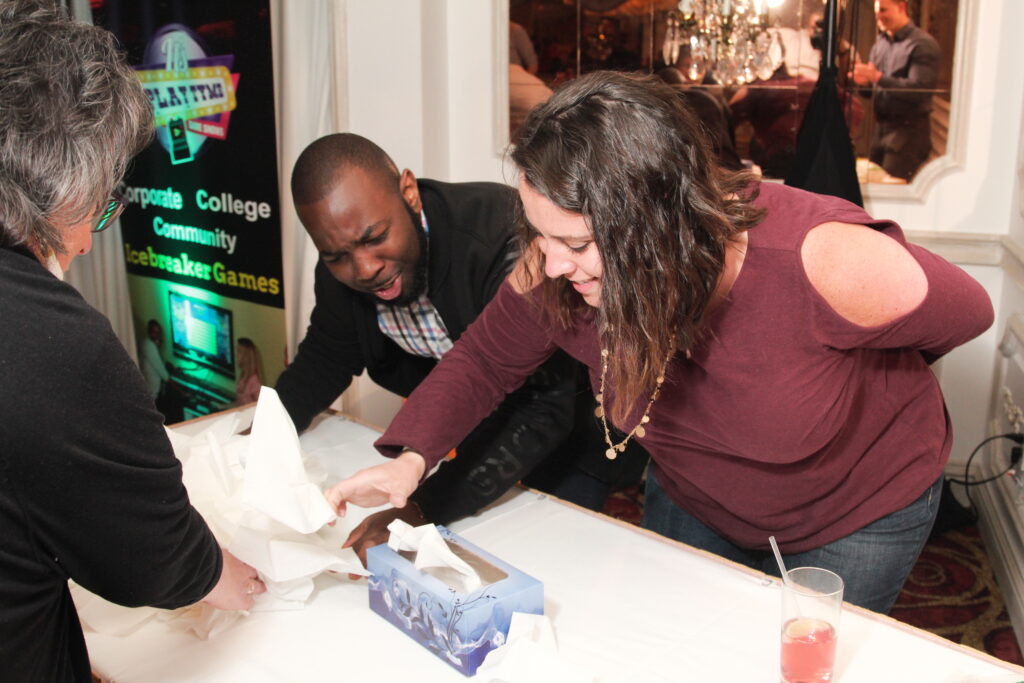
Teamwork – Communication
Team Building Activities to Improve Communication
Improving communication is a key aspect of successful team building, and specific activities can help teams achieve this. Effective communication is the foundation upon which successful teams are built, enabling them to collaborate efficiently, resolve conflicts, and achieve their goals.
Several activities are designed to improve communication skills, both verbal and non-verbal. These activities not only enhance how team members interact with each other but also foster a more cohesive and productive work environment.
Human Knot Exercise
The Human Knot is a popular team activity that requires participants to stand in a circle and join hands with two different people across from them, not adjacent to them. The objective is to untangle themselves without releasing their hands. This exercise promotes verbal communication and problem-solving.
For a group size of 8-16 people, this activity takes about 20-30 minutes. It encourages team members to communicate clearly and work together to achieve a common goal.
Back-to-Back Drawing
In this activity, team members are paired and seated back-to-back. One person is given a simple image to describe to their partner, who then attempts to draw it without seeing the original. This exercise highlights the challenges of conveying visual information through verbal communication alone.
This activity is suitable for teams of 4 or more and takes about 5-10 minutes. It emphasizes the importance of clear and precise communication.
Birthday Line-Up (Non-Verbal Communication)
The Birthday Line-Up is a non-verbal communication exercise where team members are required to line up in order of their birthdays without speaking. This activity promotes non-verbal communication and teamwork.
For groups of 8-15 people, this activity takes about 20-30 minutes. It encourages creative problem-solving and collaboration.
The Compliment Circle
The Compliment Circle is an activity where team members stand in a circle and acknowledge the efforts and contributions of their colleagues. This exercise fosters positive communication and appreciation among team members.
Suitable for groups of 8-16 people, this activity takes about 20-30 minutes. It helps in building a supportive and encouraging team culture.
| Activity | Group Size | Time Commitment | Purpose |
|---|---|---|---|
| Human Knot | 8-16 people | 20-30 minutes | Build collaboration and improve verbal communication |
| Back-to-Back Drawing | 4+ people | 5-10 minutes | Enhance verbal communication and description skills |
| Birthday Line-Up | 8-15 people | 20-30 minutes | Promote non-verbal communication and teamwork |
| The Compliment Circle | 8-16 people | 20-30 minutes | Foster positive communication and appreciation |
These activities are designed to improve communication skills, enhance collaboration, and promote a positive work environment.
By incorporating these exercises into their team-building strategies, organizations can foster more effective and cohesive teams.
Problem-Solving Team Building Games
Problem-solving games offer a unique opportunity for teams to develop strategic thinking, creativity, and collaboration. These activities are designed to challenge teams, foster critical thinking, and encourage innovative solutions to complex problems.
The Marshmallow Challenge
The Marshmallow Challenge is a popular team-building activity that requires groups of four to build the tallest freestanding structure possible using 20 sticks of spaghetti, one marshmallow, one yard of string, and tape within 20-30 minutes. This challenge tests how creatively teams work together under time pressure, necessitating strategic thinking and collaborative construction.
Escape Room Experiences
Escape Room Experiences have gained a lot of popularity as a group activity because they demand diverse thinking styles, effective communication, and coordinated effort to solve puzzles within a limited time frame. Teams must work together, leveraging each member’s strengths to escape the room.
Spectrum Mapping for Team Solutions
Spectrum Mapping is an activity that involves presenting a team with topics for discussion, gathering their thoughts on sticky notes, and then organizing these notes to visualize the range of possible solutions. This exercise encourages both conventional and unconventional thinking, promoting a collaborative approach to problem-solving.
What Would “X” Do? Perspective Exercise
This exercise challenges team members to approach a problem from different viewpoints by adopting the mindset of admired figures. It helps break established thinking patterns, fostering creativity and innovative problem-solving.
Frostbite: Arctic Survival Simulation
Frostbite is a simulation activity where teams are tasked with building a shelter to survive in an Arctic environment. With a designated leader guiding blindfolded team members, this exercise emphasizes the importance of trust, clear communication, and cooperation.
As teams navigate these problem-solving games, they develop critical skills that are transferable to the workplace. “Teamwork makes the dream work,” as the saying goes, and these activities are a testament to the power of collaborative effort.
By incorporating these activities into their team building strategies, organizations can foster a culture of collaboration, creativity, and strategic thinking.
Creative Thinking Team Building Exercises
Creative thinking team building exercises are designed to challenge conventional thought patterns and encourage innovative problem-solving. These activities help teams develop the ability to approach challenges from different angles, fostering a culture of creativity and innovation within the workplace.
Classify This: Object Categorization
This activity involves grouping various office objects into categories based on common characteristics. Teams of 8-16 people are given around 20 different objects, such as coffee supplies, paperweights, and water bottles. The task requires team members to collaborate, identify patterns, and present their reasoning behind the categorization.
Sales Pitch: Everyday Object Edition
In this exercise, team members select an everyday office object and create a sales pitch to promote it. With a time commitment of 45 minutes, this activity encourages quick thinking, creativity, and persuasive communication. Each object is given a name, logo, and motto, and teams present their pitches on a whiteboard.
Salt and Pepper Pairing Game
Played in pairs, this game involves labeling each participant with a name taped to their back. Team members must ask yes or no questions to figure out their assigned “pair” (e.g., macaroni and cheese, peanut butter and jelly). This activity develops deductive reasoning and questioning skills, promoting collaboration.
Back of the Napkin Innovation Challenge
Divided into teams of 2-4, participants are presented with open-ended problems, which can be work-related, imaginary, or environmental. With a napkin and pen, teams sketch or write their solutions, which are then presented to the group. This exercise simulates spontaneous creativity and forces teams to distill complex problems into simple visual solutions.
These creative thinking exercises not only enhance problem-solving skills but also encourage innovative approaches to workplace challenges. By practicing these activities, teams can develop a more adaptable and creative mindset, driving business success.
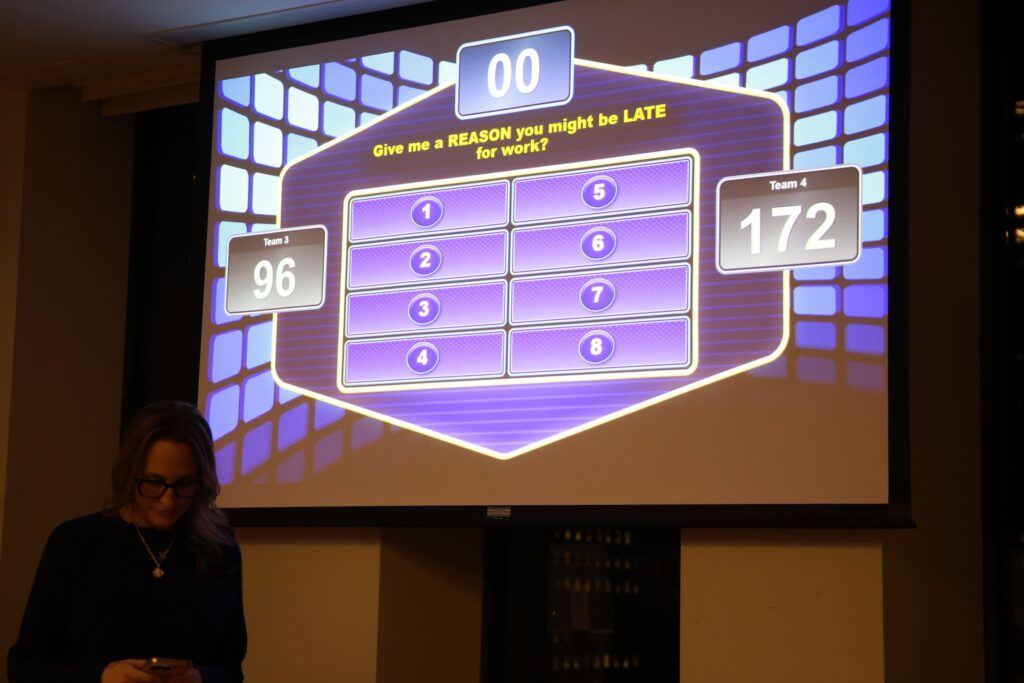
feud work question sudden death round
Workplace Team Building Activities for Trust Development
Trust is the foundation of any successful team, and workplace team-building activities play a crucial role in developing it. Trust development activities address one of the most fundamental aspects of effective teamwork – the ability to rely on one another in challenging situations.
Several team-building activities can help foster trust among colleagues. These activities are designed to promote reliance, communication, and cooperation among team members.
Minefield Navigation Exercise
The Minefield Navigation Exercise is a trust-building activity that involves guiding a blindfolded team member through an obstacle course. This exercise requires clear communication and builds trust through guided navigation. To play this game, around 20 small objects are required, and team members are paired up, with one being blindfolded and the other acting as their guide.
Trust Fall and Its Modern Variations
Trust Fall is a classic trust-building exercise that involves physical demonstrations of trust. While traditional Trust Fall can be intimidating, modern variations offer less intimidating alternatives that still build mutual confidence. These variations can be adapted to suit the comfort level of the team.
Perfect Square Team Challenge
The Perfect Square Team Challenge requires blindfolded participants to form a perfect square with a rope through verbal communication alone. This activity builds trust in colleagues’ guidance and problem-solving abilities. In groups of six, team members form a circle around a rope and are blindfolded to begin the game.
Life Map Sharing Exercise
The Life Map Sharing Exercise develops deeper trust through vulnerability, as team members create visual representations of their life journeys and share significant experiences with the group. This activity encourages visual thinking and creates deeper connections and shared understanding among team members.
These trust-building activities create psychological safety within teams, which research shows is one of the strongest predictors of team effectiveness and innovation. By incorporating these activities into workplace team building initiatives, organizations can foster a culture of trust and cooperation.
Outdoor Team Building Activities for 2025
In 2025, companies are turning to outdoor activities to boost morale, encourage teamwork, and create lasting memories among employees. These activities not only provide a welcome break from the office environment but also leverage the benefits of fresh air and physical activity to enhance collaboration and creativity.
Modern Scavenger Hunts with AR Technology
Modern Scavenger Hunts incorporate augmented reality (AR) technology to create interactive experiences where teams use smartphones to find virtual clues and complete challenges in physical locations. This activity encourages teams to work together, exploring their surroundings in a fun and engaging way.
- Promotes teamwork and collaboration
- Utilizes technology to enhance the scavenger hunt experience
- Can be adapted to various environments, from office parks to city landscapes
Team Olympics: Friendly Competition
Team Olympics structures friendly competition through various athletic and skill-based events, fostering team spirit and allowing different strengths to shine while creating memorable shared experiences. This activity is ideal for teams looking to bond over some friendly competition.
- Encourages healthy competition among team members
- Develops teamwork and communication skills
- Can be tailored to suit different team sizes and abilities
Eco-Challenge: Environmental Team Projects
Eco-Challenge activities combine team bonding with environmental consciousness through projects like habitat restoration, community garden creation, or sustainability initiatives that make a positive impact. These activities not only foster teamwork but also contribute to the community.
- Promotes environmental awareness and sustainability
- Encourages collaboration on meaningful projects
- Can enhance the company’s social responsibility image
Adventure Courses and Obstacle Challenges
Adventure Courses and Obstacle Challenges push teams beyond their comfort zones with physical challenges that require spotting, supporting, and encouraging one another through difficult terrain. These activities are designed to build trust and strengthen team bonds.
- Builds trust and reliance among team members
- Develops problem-solving and communication skills
- Provides a thrilling experience that teams will remember
Outdoor team building activities for 2025 are designed to be engaging, challenging, and fun, providing a unique opportunity for teams to bond outside the traditional office setting. By incorporating advanced technology, environmental awareness, and physical activity, these activities cater to a wide range of interests and preferences, ensuring that there’s something for every team.
Indoor Team Building Activities for Limited Spaces
Indoor team-building activities offer a practical solution for organizations facing spatial or budget constraints. These activities are designed to foster teamwork, improve communication, and boost morale among team members, all within the confines of an office or indoor setting.

The Egg Drop Challenge
The Egg Drop Challenge is an engaging team-building activity that tests teams’ engineering and problem-solving skills. Participants are given various materials to design a protective structure for a raw egg, which is then dropped from a height. This activity promotes teamwork and creative thinking.
Group size: 5-8 people; Time commitment: 20-30 minutes. The egg drop challenge encourages collaboration and innovation among team members as they work together to build a structure that can withstand the egg drop.
Office-Friendly Board Games
Office-friendly board games provide a ready-made framework for collaboration, strategic thinking, and friendly competition. These games are easily accessible and can be adapted to suit various team sizes.
Group size: 8-20 people; Time commitment: 20-30 minutes. Board games are an excellent way to encourage teamwork and camaraderie in a relaxed setting.
Gutterball: Collaborative Ball Transport
Gutterball is a unique team building activity that challenges teams to transport a ball across a room using makeshift gutters or tubes. This activity requires coordination and communication among team members.
Group size: 8-20 people; Time commitment: 30-60 minutes. Gutterball promotes teamwork and problem-solving as participants work together to navigate the ball through the course.
Room Escape Boxes
Room Escape Boxes bring the popular escape room experience into any indoor space. Teams must solve puzzles and challenges to escape the box, promoting collaborative problem-solving skills.
Room Escape Boxes are an engaging way to challenge teams and foster collaboration in a fun and interactive environment.
Swift Swap Observation Game
The Swift Swap Observation Game is a fun and interactive activity that develops attention to detail among team members. Teams are challenged to identify changes made to the appearance of opposing team members.
Team size: 10-20 people; Time: 10-15 minutes. This game enhances observational skills and promotes teamwork as participants work together to identify the changes.
Indoor team-building activities like these are essential for organizations with limited space or budget constraints. They offer a range of benefits, from improved communication and collaboration to enhanced problem-solving skills and morale.
Virtual Team Building Activities for Remote Teams
As remote work continues to shape the modern workplace, virtual team-building activities have become crucial for maintaining team cohesion. With the rise of hybrid and remote work arrangements, companies are looking for innovative ways to foster collaboration and camaraderie among their teams.
Virtual Coffee Mornings
Virtual Coffee Mornings create informal social spaces for remote team members to connect on a personal level, mimicking the spontaneous break room conversations that happen naturally in physical offices. For a team of three or more, schedule regular coffee calls to give everyone a chance to get to know each other. These casual calls can be held once a week, bi-weekly, or once a month, depending on the team size and interest.
Online Trivia and Game Nights
Online Trivia and Game Nights bring fun competition to virtual environments, with platforms specifically designed for remote team building making these activities more engaging than ever. For teams of six to twenty people, host a virtual trivia night at the end of the workday, using themes like office trivia, TV shows, or music.
“The future of team building is digital, and it’s exciting to see how technology is enabling new forms of collaboration and connection,” said Jane Smith, a remote work expert.
Remote Lunch and Learn Sessions
Remote Lunch and Learn Sessions combine professional development with team building, allowing team members to share expertise while creating a shared learning experience. For teams of five or more, hold a weekly or monthly “lunch and learn” where one team member presents a topic to the whole team during their lunch break.
Virtual Show and Tell
Virtual Show and Tell encourages personal sharing as team members present meaningful objects from their home environment, providing glimpses into their lives outside work. For teams of three or more, ask everyone to bring something they’re proud of or that brings them joy to the next meeting, and give each person two to three minutes to show off their item and answer questions.
Photo Caption Contests
Photo Caption Contests spark creativity and humor as team members create captions for funny or unusual images, generating shared laughter that builds team bonds across distance. For teams of five or more, collect a few funny photos, send them to the team before the meeting, and ask everyone to submit their best photo caption for each image.
By incorporating these virtual team-building activities into their routine, remote teams can strengthen their connections, improve communication, and maintain a positive team culture despite physical distance.
Strategic Team Building Activities for Leadership Development
Developing leadership skills is crucial for the success of any organization, and strategic team building activities play a vital role in this process. These activities are designed to enhance leadership development within teams by focusing on strategic thinking, problem-solving, and collaboration.
Strategic team building activities help identify and develop leadership potential within teams. By observing team members during these activities, organizations can identify individuals who naturally take charge, excel at organizing information, or effectively motivate others.
Company Concentration Memory Game
The Company Concentration Memory Game is a fun and interactive way to help team members internalize important company information. This activity involves creating cards with company facts, such as the logo, mission statement, or values, and having team members match the cards.
This game is suitable for 3-6 people and requires a time commitment of 20-30 minutes. It not only enhances memory and focus but also promotes team engagement and excitement for upcoming goals.
All the News: Future Headlines Exercise
The “All the News: Future Headlines” exercise encourages teams to think forward and create newspaper headlines announcing future achievements. This activity is ideal for 8-20 people and requires 45-50 minutes.
By working backward to identify the steps needed to achieve these future headlines, teams develop strategic thinking and problem-solving skills. This exercise can be adapted for both in-office and remote teams.
Code of Conduct Creation
Creating a code of conduct is an effective way to establish shared values and behavioral expectations within teams. This activity involves brainstorming ideas that are both meaningful and enjoyable for a project or workshop.
For teams of 5 or more, this activity takes 20-30 minutes. By recording these values in a shared tool, teams can establish a code of conduct that serves as a reminder to uphold these values throughout the project.
Slideshow Collaborative Presentations
Slideshow Collaborative Presentations challenge team members to analyze complex topics and present them clearly to colleagues. This activity is suitable for 8-20 people and requires 45-50 minutes.
By working in groups to analyze and present ideas, team members develop both analytical and presentation skills. This activity promotes collaboration and strategic thinking within teams.
| Activity | Group Size | Time Commitment | Purpose |
|---|---|---|---|
| Company Concentration Memory Game | 3-6 people | 20-30 minutes | Internalize company information and promote team engagement |
| All the News: Future Headlines Exercise | 8-20 people | 45-50 minutes | Develop strategic thinking and problem-solving skills |
| Code of Conduct Creation | 5+ people | 20-30 minutes | Establish shared values and behavioral expectations |
| Slideshow Collaborative Presentations | 8-20 people | 45-50 minutes | Develop analytical and presentation skills |
These strategic activities not only enhance leadership skills but also promote a culture of collaboration and strategic thinking within organizations.
Team Building Activities for Small Groups
Small groups benefit significantly from tailored team-building activities that enhance cohesion and productivity. These activities are particularly valuable for tight-knit teams, startups, or department subgroups that need to work closely together.

Three-Question Mingle
The Three Question Mingle is an activity designed to break the ice, deepen team bonds, and encourage networking and movement among team members. Participants write three questions on sticky notes, have a one-minute meeting with another person to ask one question, and then trade those post-its. This activity allows team members to ask the questions they really want to ask, fostering meaningful conversations and helping the team get to know each other.
9 Dimensions Team Building Activity
This activity focuses on building relationships by evaluating and sharing perspectives on team dynamics. Team members are given a set of colored dots to rate their performance across nine key dimensions. By sharing their perspectives, the team surfaces areas of strength and improvement, creating a shared understanding of their dynamics and aligning on common goals.
Four Quadrants Drawing Exercise
The Four Quadrants Drawing Exercise is designed to facilitate getting to know each other and improving non-verbal communication. Team members draw responses to four questions in a grid format, encouraging visual self-expression and making it easier for introverts and visual thinkers to share their thoughts.
Sync Claps Coordination Game
Sync Claps is a fast-paced exercise that encourages presence, focus, and energizes the group. Team members stand in a circle and pass claps around, synchronizing their actions. This activity builds rhythm and synchronization, creating a physical metaphor for workflow coordination and helping the group feel more connected.
These team-building activities for small groups are designed to create meaningful connections, improve communication, and enhance collaboration. By incorporating activities like Three Question Mingle, 9 Dimensions Team Building Activity, Four Quadrants Drawing Exercise, and Sync Claps Coordination Game, small teams can significantly improve their dynamics and productivity.
Quarterly Team Building Challenges for Long-Term Engagement
Quarterly challenges offer a fresh approach to sustaining team bonding and employee engagement throughout the year. By integrating these challenges into your team’s routine, you can create a more cohesive and collaborative work environment.
These challenges are designed to be flexible and adaptable to various team sizes and types. Whether your team is small and agile or large and distributed, quarterly challenges can be tailored to meet your specific needs.
Wellness Challenges
Wellness Challenges encourage healthy habits while building team support systems. Participants can track their progress in areas like step counts, meditation minutes, or healthy meal preparation. This not only improves individual well-being but also fosters a sense of camaraderie among team members.
Skill Development Competitions
Skill Development Competitions allow team members to improve professionally relevant skills in a supportive, competitive environment. Whether it’s learning new software, practicing presentations, or developing industry knowledge, these competitions promote growth and development.
Charitable Team Projects
Charitable Team Projects combine team building with social responsibility. Teams work together toward fundraising goals or volunteer hours for causes they collectively select. This approach not only enhances team bonding but also contributes to the greater good.
Personal Growth Initiatives
Personal Growth Initiatives focus on individual development within a team context. Team members set personal goals and receive support and accountability from their colleagues. This initiative helps in creating a supportive and motivating work environment.
Quarterly team building challenges extend engagement beyond one-off activities, creating sustained team bonding experiences that evolve over time. These long-term challenges maintain employee engagement between more intensive team building events and create natural opportunities for celebration when goals are achieved.
- Wellness Challenges promote healthy habits and team support.
- Skill Development Competitions enhance professional skills.
- Charitable Team Projects foster social responsibility.
- Personal Growth Initiatives support individual development.
Measuring the Success of Your Team Building Activities
The true value of team building activities lies in their ability to positively impact the workplace, which can be measured through careful evaluation. To understand the effectiveness of these activities, organizations must adopt a comprehensive approach to measuring their success.
Key Metrics for Evaluation
To assess the impact of team building activities, it’s essential to establish Key Performance Indicators (KPIs) that capture both quantitative and qualitative outcomes. Quantitative metrics may include employee retention rates, productivity measures, and other relevant data points that indicate the health and efficiency of the team.
Qualitative assessments, on the other hand, focus on aspects such as improved communication, increased trust among team members, and enhanced collaboration. By combining these metrics, organizations can gain a holistic view of how team building activities are influencing team dynamics and overall performance.
Gathering Participant Feedback
Gathering feedback from participants is a critical step in understanding the effectiveness of team building activities. This can be achieved through surveys, interviews, or facilitated discussions that provide direct insight into which activities resonated most strongly with participants and why.
Feedback mechanisms should be designed to capture both immediate reactions to the activities and longer-term impacts on how team members work together and approach challenges. This information is invaluable for refining future team-building initiatives and ensuring they remain relevant and engaging.
Tracking Team Performance Over Time
Tracking improvements in team performance over time is essential for connecting team-building efforts to business outcomes. By monitoring changes in team dynamics, productivity, and other key metrics, organizations can demonstrate the ROI of their team-building activities beyond mere participation or enjoyment.
Effective measurement involves observing real workplace behaviors after team-building events, such as increased collaboration, more open communication, or a greater willingness to help one another. These observations provide tangible evidence of the impact of team-building activities on team performance and overall employee engagement.
In conclusion, measuring the success of team-building activities requires a multifaceted approach that includes establishing relevant KPIs, gathering participant feedback, and tracking long-term changes in team performance. By adopting this comprehensive strategy, organizations can ensure that their team-building initiatives are not only enjoyable but also contribute significantly to enhancing team building and overall employee engagement.
Conclusion: Creating a Culture of Continuous Team Building
The key to a successful organization lies in its ability to foster a culture of continuous team building. Team-building activities are a core component of work life, and any company invested in developing effective workers should engage in these activities. These opportunities for team bonding foster friendship and community within the workplace, improving worker satisfaction and happiness. Around 13% of employees assert that they are more productive when happy.
Creating a culture of continuous team building means integrating collaborative activities into the regular rhythm of work rather than treating them as occasional special events. Successful organizations recognize that team building is not a one-time fix but an ongoing process that requires consistent attention and resources. This approach helps employees develop stronger bonds with one another and the organization, leading to higher retention and engagement.
Leadership plays a crucial role in modeling the importance of team relationships by participating fully in activities and demonstrating vulnerability and openness. The most effective team-building cultures encourage organic, employee-initiated activities alongside more structured programs, allowing team members to take ownership of their relationships. As work environments continue to evolve in 2025 and beyond, organizations that prioritize helping people work together effectively will maintain a competitive advantage through stronger innovation, adaptability, and employee satisfaction.
By making team building a continuous process, companies can form stronger ties between workers and the organization, ultimately leading to a more productive and happy workforce.
